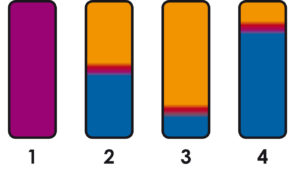Why do you actually need both?
Two-zone loading and two-zone unloading?
Which by now word has got around ...

States of charge in the buffer storage tank
is that the best possible stratification is the be-all and end-all of the efficient use of buffer storage tanks. Because only the best possible stratified storage tank can still absorb heat when it is already relatively full and release heat when it is already relatively empty. The secret of this benefit lies in the fact that with good stratification the storage tank is always hot at the top and always cold at the bottom (Fig., buffers 2-4), while the thoroughly mixed storage tank is warm from top to bottom (Fig., buffer 1). The border between hot and cold should be as abrupt as possible. The fuller the storage tank, the lower (picture, buffer 3), the emptier it is, the higher (picture, buffer 4) this limit is. In any case, a well stratified storage tank should not contain any hot water at all.
A misconception that many still succumb to
Many of our customers have found that they have been able to improve the stratification of their buffer tanks so significantly by using the two-zone unloading assemblies rendeMIX 3×2 (for one heating circuit) or rendeMIX 3×4 (for two heating circuits) that the overall efficiency of solar systems has increased noticeably and operators are highly satisfied. Others have found that the two-zone charging assembly rendeMIX 2×3 (with return boost for a wood boiler or CHP) also brings them noticeable benefits. What few have realised, however, is that it is precisely the combination of both processes, i.e. the simultaneous use of two-zone charging and two-zone discharging, that first inspires the buffer storage tank to absolute peak performance. To do without one of the two just because you are doing the other is simply to settle for a significantly worse result.
Why is the combination of both methods so successful?
Both methods primarily focus on the weak point of every cylinder, the hot water at medium temperature. Unfortunately, this is created again and again by unavoidable turbulence in the cylinder, which can never be completely avoided, even with the most sophisticated inner workings. However, the systematic and prioritised use of this warm, mixed water ultimately makes it possible to "dynamically tidy up" the cylinder. This means that the stratification is improved as the heat is transported through the cylinder. The assumption that the buffer cylinder is first charged by the heat source and only then discharged by the consumers is unrealistic. In fact, both processes always take place more or less simultaneously.


